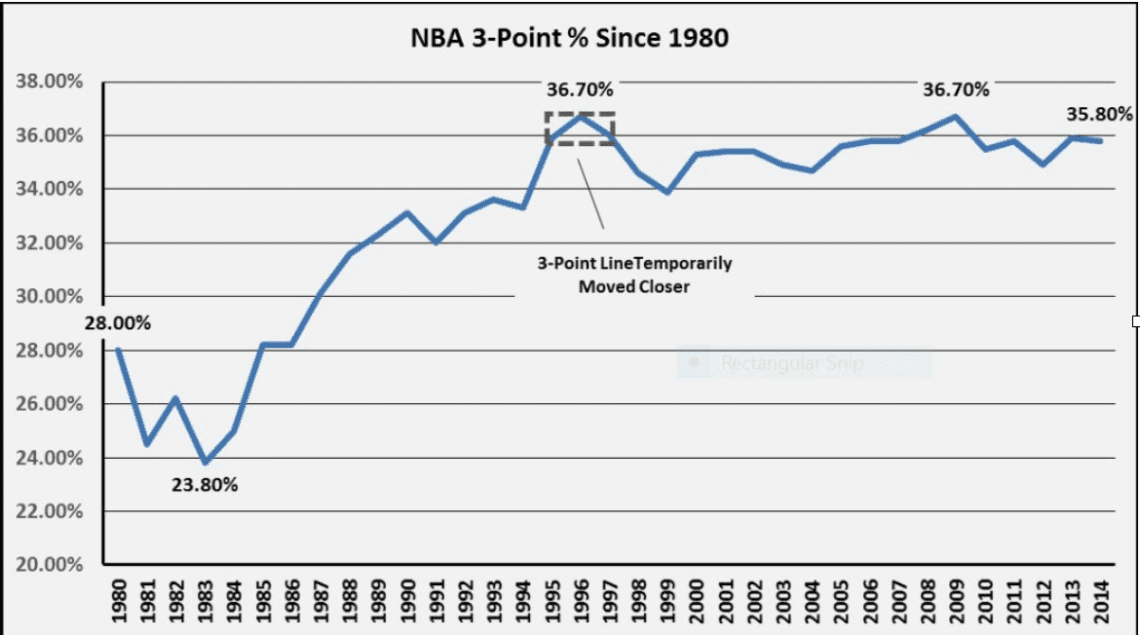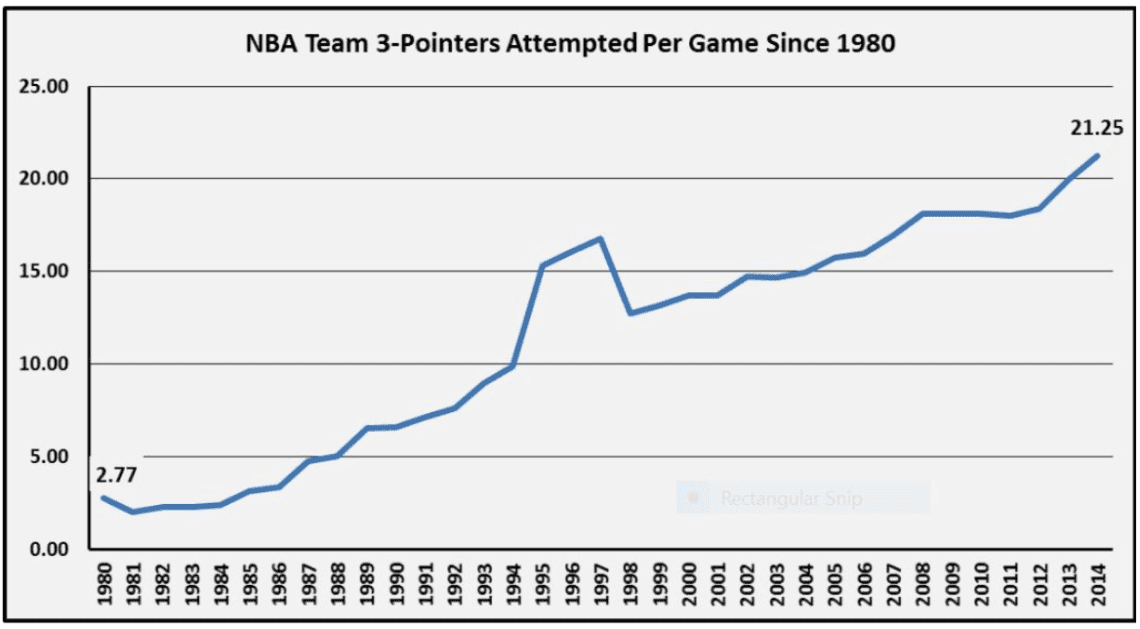Teams have stopped playing zone in modern day NBA because everyone, including the center, can knock a three, right? Not so fast, buddy! The three-point shot is the most critical factor in why the zone is not a viable option in the NBA, but not because people are any better at shooting from out there. Rather it’s the awareness of the shot that makes it important. The death of the zone is a consequence of more sophisticated and precise strategy, not improved development in offensive players.
The NBA wasn’t excited about the concept of a zone in the first place. Zone defense was outlawed in the 1940s. You read that right. Zone defense wasn’t chosen to be ignored, but rather banned for fear of changing the game. This also had something to do with the fact that there was no three-point line at the time. The concept of a defense that forces people into outside shots too irresistible to allow based on the inefficiency of only shooting from the field for two points.
In the late 1970’s, the three-point shot made basketball a completely different sport. Not coincidentally, in the early 1980s that meant there were some modifications to the zone defense laws. Defensive players were given the ability to legally go within 16 feet (but not 12) of the hoop if their man wasn’t near there. Essentially, players were allowed to apply zone principals to their man, being ready to help and do things like slough in on the weak side or double the ball if someone got beat.
Pretty absurd that team defense was even remotely frowned upon.
Imagine if that was a modern day rule in the NBA. A team could move all their players out of the paint and have their best slasher go directly into the lane without a second line of defense. Imagine trying to stop Lebron James in a situation like that.
The point is, a zone defense wasn’t technically a legal option until nearly the 21st century and three pointers beat it to the game.
So why did it die?
It is tempting to say because coaches have been forcing kids to shoot more threes and a team with only range capable shooters on the floor in the modern day NBA is considered a bad shooting team. But actually people haven’t gotten much better at shooting threes. The league average has been around 35% for years, and the Golden State Warriors have only completed two seasons shooting above 40%. Only once in their decade tenor as the greatest shooting team of all-time.

So why did this take so long?
It wasn’t about the three-point shot being around. It wasn’t that people got better at it. It was that people became more aware of it. Note the steady rise in three point attempts through the years. NBA teams are seeking out three pointers, not settling for them. This is a product of teams actually taking time to look at the math.
The current worst three-point shooting team is the NBA team is the Phoenix Suns. Even they shoot above 32%. That is the equivalent of hitting 45% of your two-pointers. The average NBA player hits under 40% of their non-layups regardless of where they are from, meaning if you don’t get a lay up on a given possession, you should look to shoot a three.

So why isn’t this true in college?
The three-point shot is much more effective. It stands to reason that it would be even more crippling to allow the three-point shot in college. My response to that is a zone defense in the NCAA isn’t an automatic uncontested three pointer.
To illustrate this let’s look at the most iconic zone defense of all time, the Syracuse 2-3 zone.
Jim Boeheim’s defense consistently holds teams under 35% from a shorter three-point arc. How is that possible? Oddly enough, it’s because of the shorter three-point line. The Syracuse zone does not fulfill the stereotype of your “passive zone.” In fact, it is very aggressive. When the ball goes to one side of the perimeter. You will see all five defenders rapidly shift to the far corner of their zones. This allows the closest defender to press all the way out and heavily the contest the three-point line without much consequence, because he has help behind him.
While the closer line makes for an easier shot, it makes for an easier defensive rotation. The arc is somewhere between 14 and 17.5% shorter, and that’s if you’re running from under the basket, which doesn’t happen. Normally you’re running from somewhere like the the elbow to somewhere like the wing, making the extra yard even more significant.
Most coaches believe in getting the ball to the high post to beat a zone.
In college, the Syracuse zone would still be able to collapse and get out to cover the three-point line. If this were done in the NBA, as soon as the defense would have to collapse to cover the high post, a pass to someone standing beyond the arc would lead to a collapse. The zone principles prevalent in man-defense (defensive switching, rotations) remain more important than ever.
Zone defenses are still perfectly effective at the non-NBA level, and are important when run correctly. I just don’t see them ever coming back to the big time.







